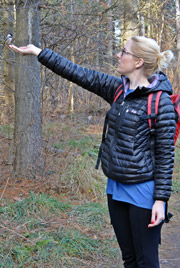Celebrating wetland conservation: NAWCA turns 30
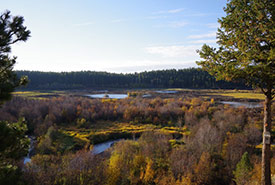
Picturesque Cherry Meadows, BC (Photo by Carol Latter)
This month, the North American Wetlands Conservation Act (NAWCA) turns 30. Passed on December 13, 1989, NAWCA is one of the most successful pieces of conservation legislation in U.S. history.
Under the Act, the U.S. Fish and Wildlife Service provides funding for wetland conservation projects throughout North America — to protect, restore and enhance habitat for waterfowl and other wetland-dependent species. Through land securement, restoration and essential ongoing management activities, NAWCA dollars have impacted more than 12 million hectares (30 million acres) of wetland and associated upland habitat across North America, to date.
Related content
NAWCA’s success has much to do with the innovative partnerships that formed, both to generate matching funds required to access grant funds and to deliver creative wetland conservation projects across North America. Federal, provincial, state, tribal, non-government organizations and private individuals have all worked together under NAWCA to deliver effective wetland conservation on a continental scale.
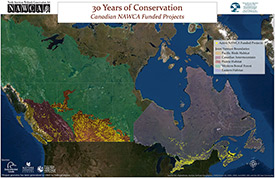
Locations of projects secured by NCC, DUC and MHHC over the past 30 years of NAWCA grant implementation. Map by North American Wetlands Conservation Council (Canada). (Click on the map to enlarge)
NAWCA projects — habitat conserved or restored with NAWCA grant or match funds — are all small pieces of a much larger puzzle. Each project conserved fits into strategic plans that are developed to ensure enough priority habitat is conserved in the right places to meet the needs of waterfowl and other migratory bird species.
In Canada, four joint ventures — voluntary partnerships of the Government of Canada, provinces and non-government conservation organizations — come together for the common cause of conserving wetland and upland habitat for waterfowl, shorebirds and other migratory birds.
The Nature Conservancy of Canada (NCC) sits on the boards of these joint ventures. We work with partners to identify priority species that require conservation investment and to identify the most important places to conserve, to provide nesting habitat and places for birds to rest and build up their reserves during migration.
But the money isn’t all for the birds; wetland conservation benefits us, too. NAWCA projects buffer us against floods, sequester carbon, clean our water and protect shorelines from erosion. And the wetlands and associated upland habitat conserved under NAWCA provide habitat for many resident Canadian species that don’t travel south for the winter.
NCC is proud to be an active recipient of NAWCA grant funds. With the support of individuals, organizations and governments on both sides of the border, over the past 19 years, NCC has conserved close to 285,000 hectares (700,000 acres) of priority NAWCA wetland and associated upland habitat across Canada. More NAWCA projects are underway to conserve more important habitat.
NCC’s on-the-ground NAWCA habitat securement program has conserved wetlands in continentally significant priority landscapes across the country — across all four joint ventures in Canada. Projects include:
British Columbia
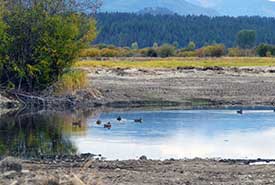
Ducks start using the new wetlands even before they are full (Photo by Carol Latter)
Cherry Meadows, located near Kimberley, BC, features 70 hectares (173 acres) of ponderosa pine forests and extensive wetlands. These wetlands were ditched and drained in the early 1900s for hay production, then became uncultivated and overrun by non-native grasses. NCC has been rehabilitating the wetlands since 2018, gradually transforming them back to their natural state. Despite the loss of habitat from its agricultural past, the area is bustling with life thanks to the restoration work. Now, even rare sandhill cranes visit and nest in its restored marshes.
Alberta
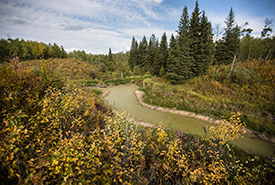
Beaver Hills, Kallal property, AB (Photo by Brent Calver)
Kallal, a 120-hectare (319-acre) property located in the internationally designated UNESCO Biosphere Reserve, contains a mix of forests, shrublands, wetlands and meadows. The natural area here connects several nationally or provincially protected areas nearby, including Elk Island National Park (a nationally designated Environmentally Significant Area), Cooking Lake Blackfoot Grazing Wildlife Provincial Recreation Area, Beaverhill Lake (an important migratory and staging grounds for shorebirds and waterfowl), Ministik Lake Game Bird Sanctuary (a globally significant Important Bird Area) and Minquelon Lake Provincial Park.
Saskatchewan
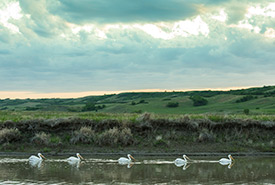
American pelicans swimming in Pasqua Lake, SK (Photo by Jason Bantle)
Pasqua Lake is a picturesque 113-hectare (280-acre) property 75 kilometres northeast of Regina. It features marshes upstream of Pasqua Lake and rolling grasslands and trees of the Aspen Parklands. This valley system provides habitat for many wildlife, including waterfowl, moose and deer, and species at risk, such as bobolink (threatened) and Sprague’s pipit (threatened).
Manitoba
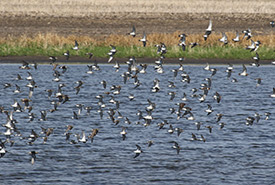
Shorebirds in flight at Jiggens Bluff 2, MB (Photo by Christian Artuso)
At 129 hectares (320 acres), over a quarter of the Jiggens Bluff 2 property in the Oak Lake Sandhills and Wetlands Natural Area is riparian marsh and wet meadow habitat. The area is a globally significant habitat for migrating waterfowl, including blue-winged teal, lesser scaup, gadwall, snow goose and sandhill crane. This abundance of birds attracts golden eagles to the area each fall to teach their young to hunt.
Ontario
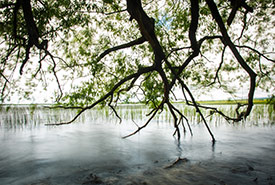
Brighton Wetland, ON (Photo by David Coulson)
Brighton Wetland is 94 hectares (231 acres) of intact coastal wetland located between Presqu’ile Provincial Park and NCC’s Willenroth Woods. One of the last undeveloped shorelines on Lake Ontario, this unique habitat is part of the Presqu’ile Bay Wetland Complex, a Provincially Significant Wetland, and the Presqu’ile Bay Important Bird Area. NCC and Ducks Unlimited Canada worked in partnership to secure this significant project under NAWCA.
Quebec
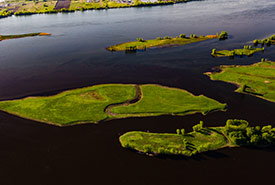
Île aux Cerfeuils, Hochelaga Archipelago, QC (Photo by Immophoto - Patrice Bériault)
NCC has unveiled recreational facilities on four of its protected islands in the Hochelaga Archipelago, at the eastern end of Montreal, which include wetlands that are rich in biodiversity. Nature lovers, outdoor enthusiasts, hikers, kayakers and canoeists now have access to the Bonfoin, Aigle, Cerfeuils and Beauregard islands. The ecosystems on the islands provide habitat for many wildlife, from large birds of prey to endangered copper redhorse, a species that can only be found in the waterways of southwest Quebec.
Atlantic Canada
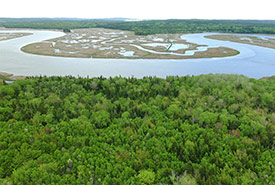
Musquash Estuary, NB (Photo by Mike Dembeck)
Musquash Estuary, near Saint John, New Brunswick, is NCC’s largest and oldest nature reserve in Atlantic Canada, and surrounds the last fully functioning river estuary in the Bay of Fundy. The reserve features 2,300 hectares (5,600 acres) of unspoiled fresh and saltwater marshes, coastal forests and cobble beaches and is a haven for wildlife, especially shorebirds. Peregrine falcon, bald eagle, beaver and the occasional bobcat can also be spotted here.
In addition to securing the land, NAWCA funding has helped NCC improve habitat conditions, restore drained wetlands, eradicate invasive species, improve nesting success and ensure that places to rest, feed and nest are available for migratory birds as they make their journey across North America.
NAWCA funding has been instrumental in restoring waterfowl populations these past 30 years, but it’s clear that continued collaboration is required to bring back many other bird groups whose populations are plummeting.
NAWCA is a testament to how conservation can work when we work together. Here’s hoping in another 30 years, we continue to celebrate NAWCA supporting continental conservation.

